Opossums – Marsupalia Didelphidae virginiana
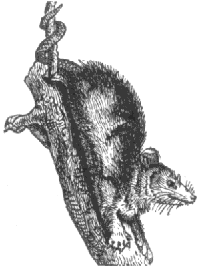 |
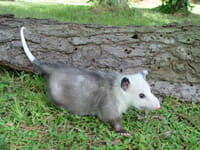 |
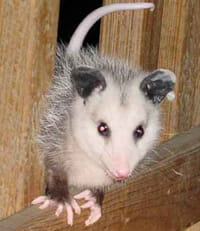 |
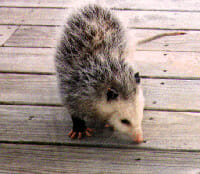 |
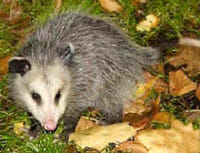 |
Identification & Description:
Opossums make up the family Didelphidae, of the order Marsupialia. The common Virginia opossum is classified as Didelphis virginiana, the yapock as Chironectes minimus.
Opossum, common name for any of 77 marsupial mammals found only in the western hemisphere. The opossum ranges in length from 17 to 104 cm (7 to 41 in), including the tail, which is from 9 to 54 cm (4 to 21 in) long. The common Virginia opossum is the largest of the opossums, measuring 109 cm (43 in), of which one-half is tail. The front feet have five toes with claws; on the hind feet the outer four toes bear claws, and the inmost toe is opposable, like a thumb, and nailless. The Virginia opossum is covered with long, sleek, white hair and an undercoating of soft, woolly fur. It has a pointed, slender face and large, broad, naked ears. An opossum has 50 teeth. Most species are omnivorous, usually preferring a diet of insects and carrion. They are nocturnal, sleeping in a burrow during the day and hunting food at night; most are arboreal. The yapock, or water opossum, of South America is aquatic, having webbed hind feet for swimming. The Virginia opossum’s habit of feigning death when threatened has given rise to the expression “playing possum.”
Most species have the abdominal pouch characteristic of marsupials; however, in some South American species this pouch is rudimentary or absent. A female opossum may have as many as 17 nipples within the pouch, but 13 is the usual number. Of the 4 to 24 young that may be born in a litter, only 8 or 9 usually survive. The gestation period is about 13 days, and the newborn opossums, about 1.4 cm (about 0.55 in) long and weighing about 0.16 g (about 0.0056 oz), are quite undeveloped. They must spend about two months in the mother’s pouch attached to the nipples before they are able to move about.
The Virginia opossum, found throughout the eastern United States and occasionally in the western states, is edible and considered a delicacy in the South. Opossum fur formerly had commercial value but is little used now. The name opossum is frequently shortened to possum, although the name possum is also used in reference to certain Australasian marsupials unrelated to opossums.
Habitat
Virginia Opossums (Didelphis virginiana) inhabit the United States east of the Rocky Mountains, Central America, and Pacific coastal North America. The Virginia Opossum is the only marsupial found in the North America. In South America and Australia there are about 80 species of Opossums.
The opossum is a medium-sized mammal about the size of a house cat, with long guard hairs that give their fur a very coarse appearance. Their coat color varies from light—almost white—to almost black, but usually looks gray. Opossums also have naked ears and a long, almost hairless, prehensile tail, which is capable of grasping and holding objects. While the tail might support the opossum’s full weight for brief periods, the animal usually uses at least one foot as well as the tail when dangling from a limb. Perhaps because of their naked tails, opossums are often mistaken for rats.
When confronted, opossums sometimes display their teeth (opossums have more teeth—fifty of them—than any other North American mammal) and may even hiss. Although this appears to signal a fierce opponent, opossums are actually shy and inoffensive. Rather than fight, they’ll sometimes slip into a state of apparent death—a reaction celebrated in our colloquial expression, “playing possum.” This state of catatonia can last a minute or two, or even as long as two hours, before the “dead” opossum revives and moves on, once the danger has passed.
Reproduction
he breeding season for Opossums begins in December and may continue through October with most of the infants born between February and June. Like all marsupials, Opossum females have a well-developed pouch. They produce an average of 7 young, once or twice a year (litters of 17 kids have been reported). At birth, the infants are hairless, embryonic-looking, and weigh about 0.1 grams because the period of gestation is 12-13 days and because they are born at a very early stage in their development. Marsupials are distinguished by their unique mode of reproduction: The young are born in an almost embryonic form and make their way to the pouch in their mother’s abdomen, where they are nourished for what in other mammals would be most of the gestational period.
Young Opossums have to make a long and difficult journey from the birth canal into the pouch and latch onto a teat. The mother helps by licking the hair leading into the pouch. There are only 13 teats in the pouch and not all may be functional, so the excess infants will not survive. The young open the eyes at around 60-70 days and are weaned at about 100 days of age. Then they are often carried as they cling onto the mother’s back. After separation from the mother, littermates may share common dens for some time. Very few young Opossums survive to become adults.
Opossums may breed twice a year and give birth to as many as 12 young, to overcome the high mortality rate that most opossum populations face—the average female opossum probably lives only a year. Young emerge from their mother’s pouch at about 1–2 months of age, then ride on their mother’s back. They become independent at about three months. Excellent climbers, opossums may take shelter by day in tree dens, old squirrel nests, or nests they’ve built themselves above ground. They can also make homes under decks or patios, and in wood- and brushpiles.
Diet & Activity
Opossums are omnivorous and consume an amazing variety of plant and animal foods. Invertebrates, such as insects, slugs, snails, and worms, can comprise a large part of their diet, and they’re not above scavenging carrion. Contrary to popular folklore, opossums very rarely raid garbage cans, poultry coops, or gardens. They are most active at night, and they have a habit of ceaselessly moving along the ground in search of food, without following trails or travel routes to places of known food sources. In fact, adult male opossums may wander continuously. Females spend their lives in more defined areas, but still move around almost randomly. Most opossums seen in yards and neighborhoods are likely to move on without human encouragement or intervention if given enough time.